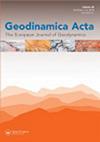Early Eocene orthophragminids (Foraminifera) from the type-locality of Discocyclina ranikotensis Davies, 1927, Thal, NW Himalayas, Pakistan: insights into the orthophragminid palaeobiogeography
IF 1.5
Q1 Earth and Planetary Sciences
引用次数: 17
Abstract
The study of isolated orthophragminid tests at the type-locality of Discocyclina ranikotensis Davies from the Patala Formation in Thal area (Upper Indus Basin, NW Pakistan) revealed new associations of genera Discocyclina Gümbel, and Orbitoclypeus Silvestri, not yet reported from eastern Tethys. We demonstrate that D. ranikotensis Davies, the species identity of which has been a subject of controversy in earlier works, is a valid species endemic at least to the Indo-Pakistan region. D. ranikotensis is associated with Discocyclina archiaci (Schlumberger), and very sparse Orbitoclypeus schopeni (Checchia-Rispoli), both species being key taxa for orthophragminid zonation in peri-Mediterranean Tethys. We have also identified a few discocyclinid specimens suggesting possible connection to western Tethys species D. fortisi, and a few specimens showing affinity to D. dispansa. The assemblages of orthophragminids suggest orthophragminid zone (OZ) 3 according to western Tethyan zonation scheme. The occurrence of D. archiaci extends the geographical distribution of this taxon to eastern Tethys, which hitherto was only known from peri-Mediterranean region. The typical western Tethyan asterocyclinids, nemkovellids and ribbed orbitoclypeids, first appearing at or around Paleocene/Eocene boundary (OZ 1B/2, SBZ4/5), have not been identified.早始新世正ophragminids(有孔虫目),来自discyclina ranikotensis, Davies, 1927, Thal, NW喜马拉雅山,巴基斯坦:对正ophragminids古生物地理学的认识
对塔尔地区(上印度河盆地,西北巴基斯坦)Patala组中discyclina ranikotensis Davies型地分离的orthophragminid试验研究发现,在特提斯东部尚未报道的discyclina g mbel属和Orbitoclypeus Silvestri属有新的关联。我们证明D. ranikotensis Davies,其物种身份在早期的工作中一直是一个有争议的主题,是至少在印度-巴基斯坦地区特有的有效物种。D. ranikotensis与Discocyclina archiaci (Schlumberger)和Orbitoclypeus schopeni (Checchia-Rispoli)有亲缘关系,这两个物种都是地中海沿岸特提斯地区orthophragminid分区的关键分类群。我们还鉴定了一些discyclinid标本,表明可能与西部特提斯种D. fortisi有联系,一些标本与D. disansa有亲缘关系。根据特提斯西部分区方案,正畸带属正畸带(OZ) 3。D. archiaci的出现将该分类群的地理分布范围扩大到特提斯东部,这一地区迄今为止只在地中海沿岸地区发现。典型的西特提斯星形旋流体、nemkovellids和纹状轨道旋流体最早出现在古新世/始新世边界(OZ 1B/2, SBZ4/5)或其附近,目前尚未发现。
本文章由计算机程序翻译,如有差异,请以英文原文为准。
求助全文
约1分钟内获得全文
求助全文
来源期刊

Geodinamica Acta
地学-地球科学综合
CiteScore
4.50
自引率
0.00%
发文量
0
审稿时长
25 weeks
期刊介绍:
Geodinamica Acta provides an international and interdisciplinary forum for the publication of results of recent research dealing with both internal and external geodynamics. Its aims to promote discussion between the various disciplines that work on the dynamics of the lithosphere and hydrosphere. There are no constraints over themes, provided the main thrust of the paper relates to Earth''s internal and external geodynamics. The Journal encourages the submission of papers in all fields of earth sciences, such as biostratigraphy, geochemistry, geochronology and thermochronology, geohazards and their societal impacts, geomorphology, geophysics, glaciology, igneous and metamorphic petrology, magmatism, marine geology, metamorphism, mineral-deposits and energy resources, mineralogy, orogeny, palaeoclimatology, palaeoecology, paleoceanograpgy, palaeontology, petroleum geology, sedimentology, seismology and earthquakes, stratigraphy, structural geology, surface processes, tectonics (neoteoctonic, plate tectonics, seismo-tectonics, Active tectonics) and volcanism.
Geodinamica Acta publishes high quality, peer-reviewed original and timely scientific papers, comprehensive review articles on hot topics of current interest, rapid communications relating to a significant advance in the earth sciences with broad interest, and discussions of papers that have already appeared in recent issues of the journal. Book reviews are also included. Submitted papers must have international appeal and regional implications; they should present work that would be of interest to many different specialists. Geographic coverage is global and work on any part of the world is considered. The Journal also publishes thematic sets of papers on topical aspects of earth sciences or special issues of selected papers from conferences.
 求助内容:
求助内容: 应助结果提醒方式:
应助结果提醒方式:


